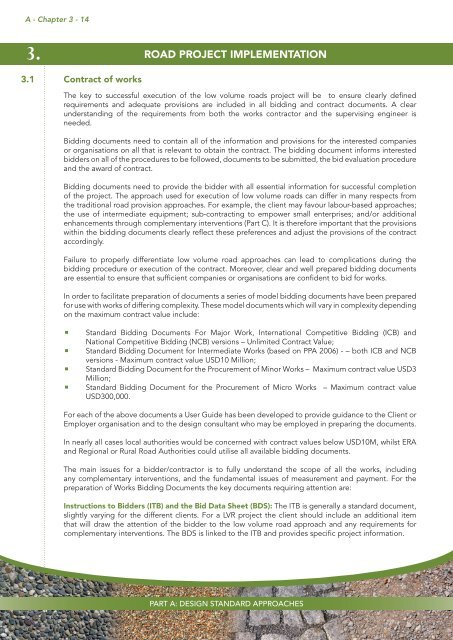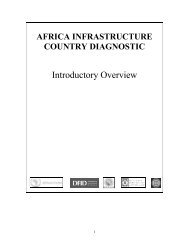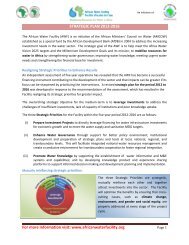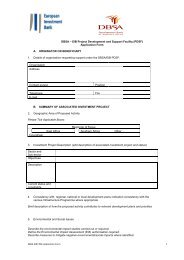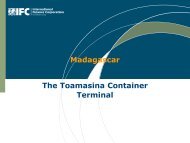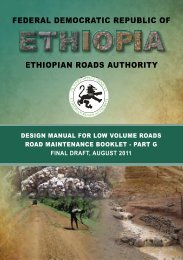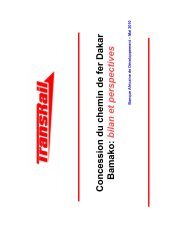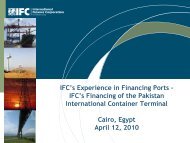Design-Manual-for-Low-Volume-Roads-Part-A
Design-Manual-for-Low-Volume-Roads-Part-A
Design-Manual-for-Low-Volume-Roads-Part-A
You also want an ePaper? Increase the reach of your titles
YUMPU automatically turns print PDFs into web optimized ePapers that Google loves.
A - Chapter 3 - 14<br />
3.<br />
ROAD PROJECT IMPLEMENTATION<br />
3.1 Contract of works<br />
The key to successful execution of the low volume roads project will be to ensure clearly defined<br />
requirements and adequate provisions are included in all bidding and contract documents. A clear<br />
understanding of the requirements from both the works contractor and the supervising engineer is<br />
needed.<br />
Bidding documents need to contain all of the in<strong>for</strong>mation and provisions <strong>for</strong> the interested companies<br />
or organisations on all that is relevant to obtain the contract. The bidding document in<strong>for</strong>ms interested<br />
bidders on all of the procedures to be followed, documents to be submitted, the bid evaluation procedure<br />
and the award of contract.<br />
Bidding documents need to provide the bidder with all essential in<strong>for</strong>mation <strong>for</strong> successful completion<br />
of the project. The approach used <strong>for</strong> execution of low volume roads can differ in many respects from<br />
the traditional road provision approaches. For example, the client may favour labour-based approaches;<br />
the use of intermediate equipment; sub-contracting to empower small enterprises; and/or additional<br />
enhancements through complementary interventions (<strong>Part</strong> C). It is there<strong>for</strong>e important that the provisions<br />
within the bidding documents clearly reflect these preferences and adjust the provisions of the contract<br />
accordingly.<br />
Failure to properly differentiate low volume road approaches can lead to complications during the<br />
bidding procedure or execution of the contract. Moreover, clear and well prepared bidding documents<br />
are essential to ensure that sufficient companies or organisations are confident to bid <strong>for</strong> works.<br />
In order to facilitate preparation of documents a series of model bidding documents have been prepared<br />
<strong>for</strong> use with works of differing complexity. These model documents which will vary in complexity depending<br />
on the maximum contract value include:<br />
• Standard Bidding Documents For Major Work, International Competitive Bidding (ICB) and<br />
National Competitive Bidding (NCB) versions – Unlimited Contract Value;<br />
• Standard Bidding Document <strong>for</strong> Intermediate Works (based on PPA 2006) - – both ICB and NCB<br />
versions - Maximum contract value USD10 Million;<br />
• Standard Bidding Document <strong>for</strong> the Procurement of Minor Works – Maximum contract value USD3<br />
Million;<br />
• Standard Bidding Document <strong>for</strong> the Procurement of Micro Works – Maximum contract value<br />
USD300,000.<br />
For each of the above documents a User Guide has been developed to provide guidance to the Client or<br />
Employer organisation and to the design consultant who may be employed in preparing the documents.<br />
In nearly all cases local authorities would be concerned with contract values below USD10M, whilst ERA<br />
and Regional or Rural Road Authorities could utilise all available bidding documents.<br />
The main issues <strong>for</strong> a bidder/contractor is to fully understand the scope of all the works, including<br />
any complementary interventions, and the fundamental issues of measurement and payment. For the<br />
preparation of Works Bidding Documents the key documents requiring attention are:<br />
Instructions to Bidders (ITB) and the Bid Data Sheet (BDS): The ITB is generally a standard document,<br />
slightly varying <strong>for</strong> the different clients. For a LVR project the client should include an additional item<br />
that will draw the attention of the bidder to the low volume road approach and any requirements <strong>for</strong><br />
complementary interventions. The BDS is linked to the ITB and provides specific project in<strong>for</strong>mation.<br />
PART A: DESIGN STANDARD APPROACHES


